Reproducing the Costume Close-up Jacket, 1775-1785:
A Step-by-Step Guide
Part Three
In the first installment of this tutorial, we covered fabric selection, enlarging the book pattern, and completing the sleeves. The second installment looked at assembling the bodice pieces and finishing the front, back neckline, and bottom edges of the jacket. This final installment concludes by focusing on all of the details you need to complete your jacket project, as well as your outfit as a whole.
Construction details: ...continued...
The Bodice: ...continued...
6) To finish the two slits at the front of the jacket, prepare two pieces of self-fabric binding. Cut two strips of fabric 1" wide and 10" long. Fold the strips in half lengthwise and crease to mark that measurement. Then, holding the fabric wrong side up, fold the sides in to meet that center fold mark and then fold the whole thing in half again, re-creasing the center fold. The creates finished edges that will bind the slits.
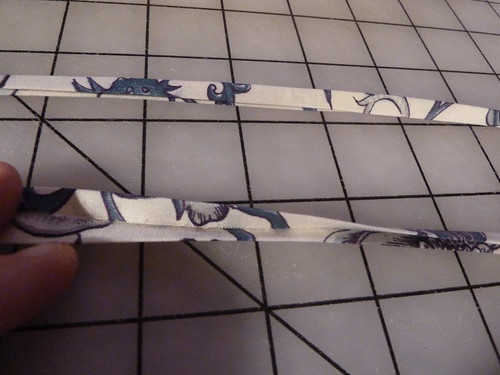
Folding the strips to create the binding for the front "slits" that
shape the front the jacket.
Begin attaching your binding at one end of the bottom of the slit, leaving about 1/2" hanging over the bottom edge of the jacket. Work the binding around the slit, carefully fiddling it into the top corner and back down around the other side. With the jacket laying right side up, fold the ends of the binding under, so that they cover the hem, and tuck them under the binding on the other side. Use a slipstitch or a plain hem stitch to tack down the binding on both the outer side and the lining side of the jacket. (#53-57)
7) Next come the eyelets down the front. The original jacket has ten eyelets on each side, though the line drawing in Costume Close-up only shows nine per side. I opted for eight in this project, though I did nine in the pink/green/yellow Indian print, and none at all on my first version for Ashley because she perferred the cleaner look of pinned-in stomacher, rather than a laced-on one. The long and short of it is that there is no hard and fast rule about the number of eyelets on any garment: even stays varied considerably from widely spaced lacing holes to very closely placed ones, and with a jacket, you have the option (as with a gown) to simply pin the stomacher, too. Look through some period images of jackets to get a sense of how fashions were trending as far as lacing spacing, and of what look you prefer, and also consider how high or low your waist is and what looks best with your own proportions when calculating the number of lacing holes. I don't think I'd go less than maybe 7 on each side and probably no more than 10 or 11.
Mark your eyelets on the lining side of the jacket, making sure they will lace straight and not spiral (as you would for stays. I haven't found an image of a spiral-laced jacket, but if anyone else has, do please let me know so I can correct this!).

Mark the placement of the eyelets on the lining side, down
both sides of the center front of the jacket.
Using an awl, proceed eyelet by eyelet, making your hole and then finishing it before moving on to the next. Use an overcasting stitch, rather than a buttonhole stitch, to make your eyelets and work though both layers. As you move on to the next eyelet, do not cut your thread; carry it from one lacing hole to the next, as this will help keep the threads strong. This technique was used in the original jacket, and you can see an excellent picture of it in Costume Close-up, pg. 42. (#58-60)
Setting the Sleeves:
1) Before setting in the sleeves, attach the front of the shoulder pieces with lapped seams. Fold under the seam allowance of the front (straight) edge of the outer fabric shoulder pieces, place them over the seam allowance of the top edge of the jacket fronts, and stitch them down using a spaced backstitch or plain backstitch (again, whichever stitch you've been using thus far).
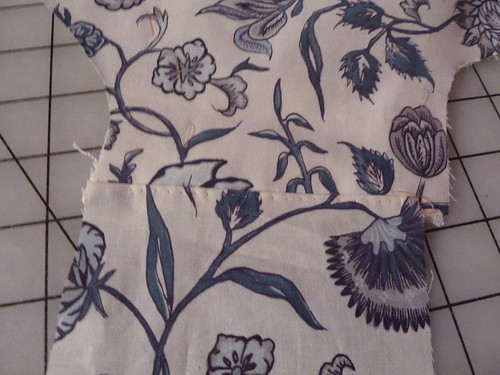
Attach the shoulder piece at the front using a lapped seam (here, the
shoulder piece is at the bottom of the photo, with the body of the jacket at the top).
Then turn the jacket lining side up and do the same for the lining pieces of the shoulder, folding their allowances under and slipstitching them down to cover the backstitching you just did. (#61-63)
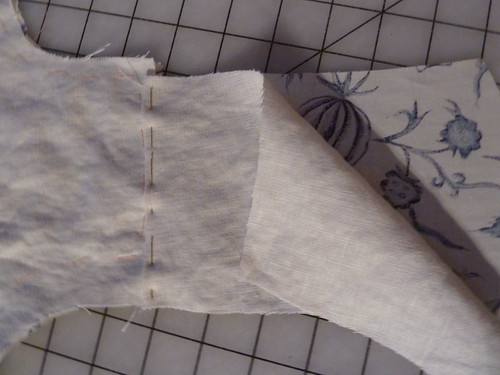
Completing the lapped seam for the shoulder pieces, folding under the
lining and slipstitching it into place.
2) Pin the sleeve into the bottom half of the armscye, positionng the sleeve seam so that it falls about 1" below the shoulder seam you just completed (**Note: this is where the sleeve seam falls in the original, and where mine fell as well, but yours might need to be different based on your own body type. The position of the sleeve within the armscye should be something you worked out in the muslin/patterning stage, but if it isn't, be sure you do that now before proceeding). Begin pinning at the sleeve seam and continue around the underarm area until you are within 1" of the top edge of the armscye on the back pieces. Backstitch - and here you have to use a regular backstitch for strength - the sleeve in between these two points, leaving the top shoulder part free. Repeat for the other sleeve.
Shoulders and Finishing the Neckline:
1) Put the jacket on over your stays and lace it closed. Pull only the lining part of the shoulder piece back to meet the top part of the back and pin it so it fits snugly. Once you get the fit, fold over the seam allowance of this lining piece along the neckline only. Backstitch the seam, thus compeleting the armscye and preparing the way to finish setting in the sleeve. Repeat for the other side.
If you have someone who can help you, they can stitch these seams without you having to remove the jacket, but if you don't have the extra set of hands, unfortunately you'll have to unlace and shed the jacket momentarily to sew your shoulder straps down before proceding. (**Note: the photos show this step and the next one being done on a dressform, but I do not recommend doing it this way because chances are the shape and angle of your shoulders change when you wear your stays, so the shoulder and sleeve cap will not fit correctly unless you fit them directly to your own body. I fit mine to myself and then switched the jacket to the dressform only so that I could get a good view for these pictures) (#64)
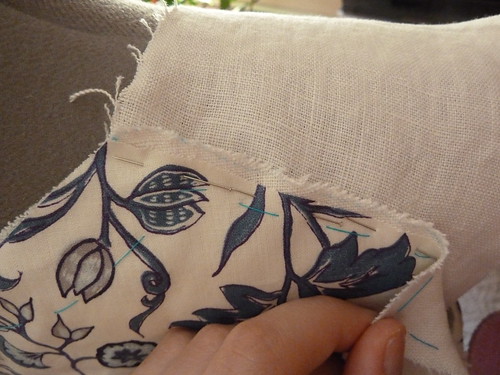
Pull the lining of the shoulder piece over your shoulder to meet the
back piece and secure it into place with backstitches. Before you sew the
seam, be sure you have folded over the seam allowance of this lining piece
along the neckline edge.
2) Put the jacket on again and lace it closed. Pin the sleeve head onto the lining piece of the shoulder, adding small pleats as necessary to make it fit your shoulder. Stitch down the sleeve head to the lining as close as you can to the edge of the sleeve to ensure that these stitches will not show in the next step. (#65-66)
3) This step can be completed on a dressform without compromising the fit, since you've already secured all of the necessary measurements. Pull the outer fabric shoulder piece to cover the sleeve cap and lining. Fold under its seam allowances on its remaining three sides and pin it into place. Using a spaced backstitch (or plain backstitch), sew down the shoulder piece where it meets the back and along the edge that covers the top of the sleeve.
A spaced backstitch secures the outer fabric shoulder piece to the
back and to the top of the sleeve.
Fold in the seam allowances of the remainder of the neckline on the two front pieces. Then, using le point a rabattre sous la main, finish the neckline from the back of each shoulder to the top of the fronts. (#67-68)
Using le point a rabattre sous la main, finish the remainder of the neckline
along the shoulder piece and down the front pieces.
Congratulations, you've just completed your own reproduction of "the Costume Close-up jacket"! If you do use this tutorial to create something, please send us a link and/or photo - we'd love to see what you make! And, as always, if you'd like to offer suggestions or corrections to any of these steps, I'm always happy and grateful to receive your input and advice. :-)
Optional - Making a Stomacher:
1) Because of the gap that remains when the original jacket is laced, Baumgarten speculates that a matching stomacher could possibly have existed. Of course, it is perfectly acceptable to lace your jacket over your bare stays with only a neck handkerchief filling in behind the laces. But just in case you'd like to make a stomacher, we'll cover that process here. It's really quite easy: with your completed jacket laced closed over your stays, meausure the width of the gap at the top and at the waistline. Also, measure from about 1/4" to 1/2" above the topmost lace (depending on how high your want your stomacher neckline to be) down to wherever you like your stomacher to end below your waistline. Add 3" to the width measurements and 1/2" to the length measurement. Using these measurements, sketch a stomacher shape onto a piece of linen lining. You can choose to make your stomacher with a pointed or rounded bottom; either is accurate for this period.
2) Cut out your stomacher in both linen lining and outer fabric. As you did to finish the ends of the sleeves and the edges of the jacket, turn the edges of both lining and outer fabric in towards each other, again allowing the outer fabric to be turned ever-so-slightly less than the lining so that it remains visible all the way around when viewed from the lining side of the stomacher. Using le point a rabattre sous la main, finish the edges of the entire stomacher, and you're done! (#69-72)
Finishing the look: As I mentioned in the first installment of this tutorial set, one of the things that makes a jacket like this so fun is how versatile it can be: an expensive cotton print can be dressed up with a silk petticoat for a middling- or upper-class "every day" impression, or dressed down with a linen petticoat for a "best" lower class look. My personal favorite choices with my jacket are the blue/ivory changeable silk taffeta pictured in several of the previous photos, and the ivory silk taffeta in the photo at right (sorry, I didn't get a more scenic one in that petticoat!). With both petticoats, I laced the jacket with ivory silk taffeta ribbon. I also have a blue stuff petticoat that coordinates with this jacket (which I haven't actually worn yet!); with something like a wool/silk blend, I could appropriately opt for either the silk ribbon or a "less formal" choice like a narrow cotton or wool tape or cording to lace the jacket.
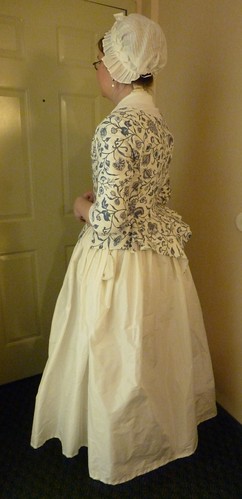 Because of the cut of the skirt on this jacket, it is necessary to wear it with some kind of bum roll or pad to achieve the proper, fashionable sillouette. It also helps the tails "poof" elegantly at the back. Be sure to cut your petticoat to accomodate the extra bum room (always shape your petticoat from the waistline, not the hemline. Period petticoats were consistently cut on the straight of grain at the hem).
Because of the cut of the skirt on this jacket, it is necessary to wear it with some kind of bum roll or pad to achieve the proper, fashionable sillouette. It also helps the tails "poof" elegantly at the back. Be sure to cut your petticoat to accomodate the extra bum room (always shape your petticoat from the waistline, not the hemline. Period petticoats were consistently cut on the straight of grain at the hem).In the pictures, I've added a cotton lawn neck handkerchief and a fine linen striped cap trimmed in ivory silk taffeta ribbon (the beautiful handwork of Mistress Nicole at Golden Hind Millinery, thank you again!), as well as pearl drop earrings (by Janice Erickson Smith) and a pearl necklace (by Ashley!) to complete the middling-class day wear look. As always, underneath are my 1780 Diderot stays and two linen petticoats.
The hat and muff featured in the "header" pictures of each of the installments were made to coordinate with this outfit, as I used the leftover bits of blue/ivory silk from my petticoat as trimmings. If you're curious about these accessories, check back for the next Threaded Bliss post!

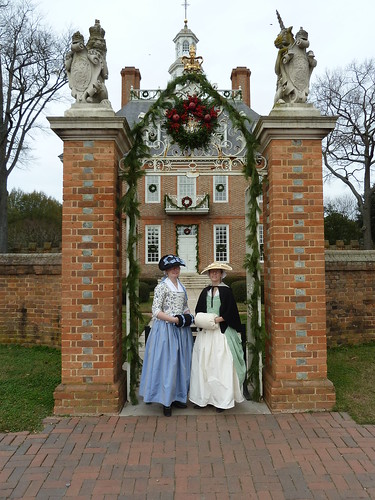
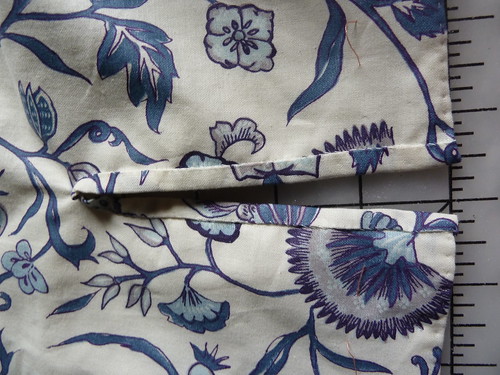
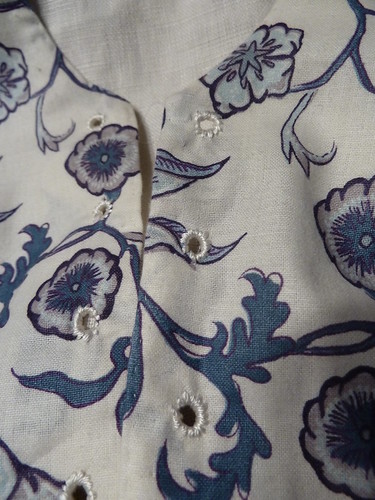
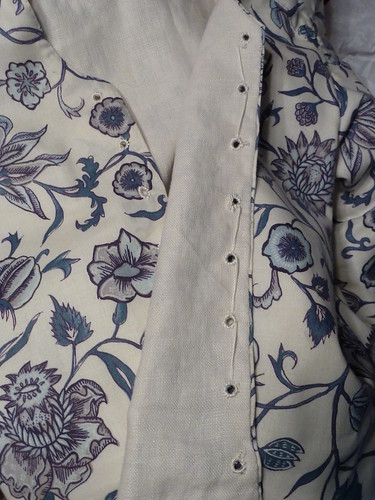
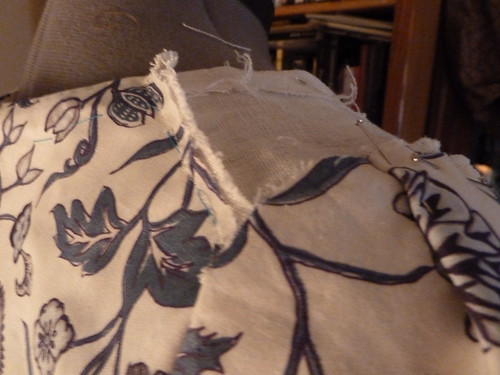
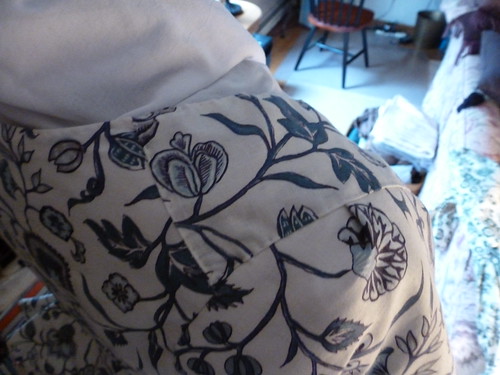
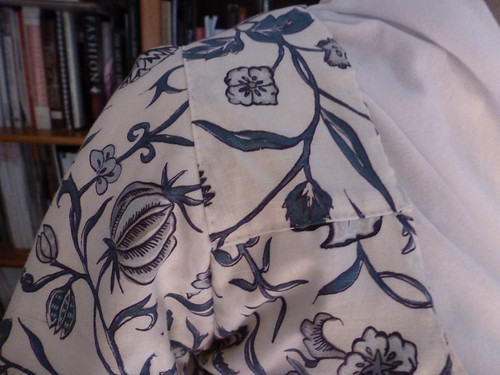

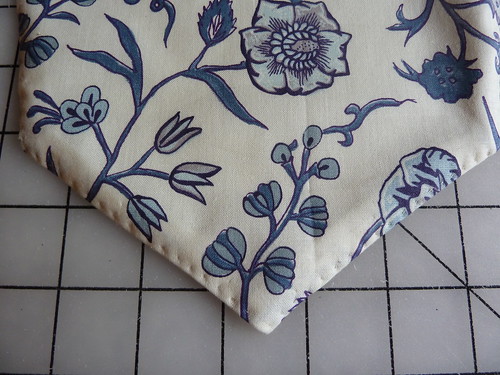
5 comments:
Rebecca,
You have no idea have invaluable this information is to me. I bought the books months ago having no idea how to convert anything over.
Thank you so much for this!
Also, it was really great to finally meet you and Ashley and your family back during the Grand Illumination. After this tutorial, you may find me in something from the 18th century the next time we meet!
Thanks again!!!
Stephanie, it was lovely meeting you (and your mum!) in person, too! I'm just sorry we didn't get more time to chat during that hectic weekend. We'll have to be sure to build that into "the schedule" next time around! :-)
I'm so very glad to hear you found the tutorial useful. I have immense confidence in your abilities to tackle a period outfit, and both Ashley and I eagerly anticipate seeing what you create! Keep us updated!
I really like this jacket !
The Fabric is really nice and it is so nice to share the whole process with us.
Thanks for sharing!
http://flouncedlucia.blogspot.com/
I've spent about 5 years away from reenacting (18th c) for various reasons, and hope to start up again, soon. I usually dress as a lower class camp follower, but I want to sew one nice gown to wear (linen only - I'm not a silk person.) I never realized that setting an 18th century sleeve was so different, and so will definitely do this! It's wonderful to know there are still so many things to learn, which is one of my favorite things about reenacting! I've seen some other tutorials for setting sleeves (thanks to Pinterest), but yours seems to be the most lucid and easy to follow, so I'm expressing my gratitude for your lovely efforts!
great job
Post a Comment